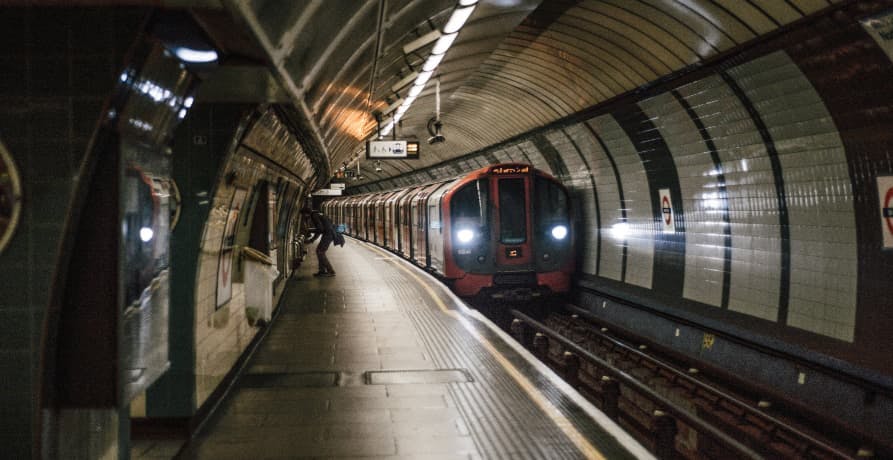ESG / CSR
Industries
How does the London Underground contribute to pollution?



The London Underground, an iconic and integral part of the UK's capital, serves as a vital transport network for millions. This article delves into its significant yet often overlooked contribution to pollution. While efficiently ferrying around 4 million passengers daily, the Underground, primarily powered by non-renewable energy sources, is a substantial energy consumer and indirect contributor to carbon emissions.
However, it's not just the energy source that raises environmental issues. The article explores the unique form of pollution generated within the Underground system, known as 'tube dust'. Although this pollution has a different chemical composition to the pollution found above ground doubts have been raised about the safety of tube dust.
👉 In this article, the London Underground's significant energy consumption and unique 'tube dust' pollution are scrutinised for their environmental and health impacts.
How is the London Underground powered?
The London Underground carries nearly 4 million passengers every day, and at its peak, there are over 540 trains travelling throughout the UK capital at any one time. Powered by electricity supplied by the national grid, it’s not surprising that the system is one of the largest energy consumers in the United Kingdom. It consumes around 1.6 terawatt-hours of energy every year - the equivalent of the amount of energy consumed by 437,000 homes.
As it stands only 16% of energy used to power the London Underground comes from renewable sources. However London’s mayor, Sadiq Khan, has announced his plan to source 100% of the London Underground’s energy from renewable sources by 2030.
Because the London Underground primarily runs on electricity sources from fossil fuels such as oil and gas, it indirectly contributes to pollution and carbon emissions in this way. It’s estimated that the underground system contributes 44 gCO2e per passenger km. However, this is a significantly lower carbon footprint when compared to other forms of transport. For example, a journey in a medium-powered petrol car emits 187 g of CO2 per km. Using the London Underground even works out as being more carbon friendly than taking the bus which accounts for 101 g of CO2 per passenger per km (petrol or diesel powered).
However, the London Underground also creates its own direct pollution through the daily wear and tear of the network, the tracks, and the carriage wheels. This pollution has come into the spotlight in recent years with many beginning to question just how harmful such particles are.
👉 If you’d like to learn more about the emissions impact of vehicles head over to our article on the topic. Or to discover which is the most environmentally friendly travel choice, the train or the car, check out our blog.

London underground tube dust
London Underground pollution is different from the pollution that you get above ground. Often referred to as ‘tube dust’, it’s made up of a combination of metal particles, organic matter, and mineral dust and is caused by the wear and tear of the London Underground tracks and wheels.
On the other hand, pollutants that you commonly find above ground, and especially in the centre of London, include fine particulate matter (PM2.5) and nitrogen dioxide. The pollution you find there is largely caused by road vehicles - they are responsible for creating nearly half of all nitrogen oxides and also emit tiny particles of rubber and metal.
The pollution that can be found above ground is harmful to human health and makes illnesses such as lung disease, asthma, cancer, and even dementia more likely. It’s thought that pollution results in the deaths of thousands of people living in London every year.
❗Researchers from King's College London estimate that around 9,400 deaths in London every year can be attributed to the inhalation of PM2.5 and NO2. Note that PM2.5 refers to particles that are 2.5 microns or less in diameter.
According to London officials, harmful pollutants such as nitrogen dioxide and diesel exhaust emissions are not produced inside the London Underground. Outdoor air pollution is classified as carcinogenic, whereas tube dust is currently not considered as such. However, that’s not to say that there’s no negative impact from the inhalation of pollution inside the London Underground and doubts have been raised in recent years as to the impacts of tube dust.
What does the research say?
Researchers from Cambridge University conducted a study into the small metal particles that can be found floating around the air inside the London Underground. The particles are so small that they’re not usually picked up by traditional methods of pollution monitoring. Pollution is typically measured using air filters, however, this method fails to capture ultra-fine particles.
The Cambridge University researchers adopted a different, more novel technique. Using magnetism researchers were able to study tube dust samples and discovered that significant amounts of maghemite (a type of iron oxide) were suspended in the air across the tube network.
The particles that they found were as small as five nanometres in diameter which makes them small enough to be inhaled and absorbed into the bloodstream. What the researchers were unable to say, however, was whether or not the particles are harmful to human health.
Other studies have similarly sought to measure the air quality of the London Underground. In 2019, the Financial Times conducted an investigation where they measured 75 different tunnel segments in central London and discovered that the levels of pollution were extremely high. They were found to be 10 times higher than the recommended limits set by the World Health Organization (WHO).
Even more concerning is the fact that the investigation team found evidence of potentially harmful particles in the London Underground - PM2.5 particles which are fine particles capable of penetrating human lungs, and with links to illnesses such as lung cancer, respiratory disease, stroke, etc. These particles are commonly found in pollution above ground (though they have a different chemical composition - more on this later).
Another study found that the air in the London Tube was up to 18 times more polluted than the air found above ground in central London. These findings seem to contradict Transport for London’s (TfL) assertion that the pollution levels below ground are safe.
London Underground particulate matter
As we've already touched on, the pollution found in the London Underground isn’t the same as the pollution that can be found above ground - they differ in terms of particle size distribution and chemical composition. Underground PM2.5 is primarily made up of dust, metal, skin, clothing fibres etc. that have built up over the decades. This pollution, which is over a century old (the London Underground is 161 years old) is constantly stirred up by the passing trains and can be found floating in the air of the London Tube network.
This is supported by the Cambridge University research team who made a surprising discovery. They found that the samples collected contained high levels of maghemite - a type of iron oxide. However, it takes a long time for iron to oxidise into maghemite, which suggests that the pollution particles are suspended in the air for long periods - increasing the risk of them being inhaled by passengers.
This finding is concerning, as is the discovery of PM2.5 particles in the London Underground, however, crucially the composition of these particles is different to PM2.5 particles found above ground (referred to as ambient particles). Underground particles are mainly composed of metals, whereas the PM2.5 particles that you find above ground tend to be a mix of many more chemicals including particles resulting from the combustion of petrol, oil, diesel, and wood.
💡 50% of ambient PM2.5 particles are made from tiny particles created by chemical reactions in the air (involving gases like nitrogen oxides, sulphur dioxide, and ammonia), one third comes directly from sources like burning fuels, and the rest is made of sea salt and mineral dust. The effects of these particles have been the subject of numerous studies and so their impacts on human health are much more known.
PM2.5 particles found on the London Tube on the other hand, are composed of iron oxide, carbon, and metallic and mineral oxides, as well as ambient air from above ground that is drawn into the system through tunnel and station entrances.
💡 Studies show that underground PM2.5 particles are around 47% iron oxide, 14% other metallic and mineral oxides, 18% carbon, and 21% unidentified substances (though this is thought to be mainly silicates). The concentration of these pollutants in the London Underground is many times higher than the concentration of PM2.5 found above ground in central London. However, the health impacts of these underground PM2.5 particles are not as well researched and therefore not well understood.
❗The concentration of PM2.5 particles in some of the deeper London Tube lines has been found to contain as much as 250 ug/m3 of PM2.5. This is 20 times higher than London’s roadside air. This is likely a result of the underground system's age and the fact that many of the lines lie within tunnels that are deep and poorly ventilated.
The impact on London Underground PM2.5 on human health
The Committee on the Medical Effects of Air Pollutants (COMEAP) is a UK body that advises the UK Government on the impact of air pollutants on human health. While acknowledging that the composition of PM2.5 particles found below ground is significantly different from PM2.5 particles found above ground, they have criticised the lack of available studies on the effects of London Underground particulate on human health and have stressed the urgent need to research its impacts. Without such studies, it is impossible to determine “the nature and extent of any health risk to those travelling on the London Underground.”
COMEAP warned that there was likely to be a health risk associated with PM2.5 exposure, even with its different chemical profile. There is already strong evidence that long-term and even short-term exposure to PM2.5 found above ground (known as ambient air pollution) is dangerous to human health, and so the likelihood is that PM2.5 found below ground also presents some kind of health risk.
However it also noted that it was unlikely that the particle mass concentrations alone are responsible for adverse health effects, and that it was estimated that different components of particulate matter result in different levels of harm. Yet, without knowledge of how the specific components of particulate matter impact the human body, it’s not possible to determine which aspects, or chemical compositions are the most harmful to human health.
Is the air inside the London Underground safe?
According to TfL the air inside the London Underground meets the UK Health and Safety Executive workplace exposure limits. Legally binding, these regulations set a limit on the level of inhalable dust that underground train operators and station staff are exposed to (over 8-hour periods). Routine monitoring over the years shows that the levels in the London Underground are more than four times lower than the workplace safety limit of 4 milligrams per cubic metre.
However, the Committee on the Medical Effects of Air Pollutants looked into relevant studies to gain an indication as to whether or not the PM2.5 particles found in the London Underground could be more harmful than presumed. They examined studies into the effects of pollution on the human body in other subway systems around the world, as well as the health impacts of iron-rich particulate matter in the iron and steel industry. While the evidence is not conclusive nor is it directly comparable to the London Underground, there is reason to believe that exposure could potentially result in inflammation of the respiratory tract alongside other ailments. CMEAP recommended that further studies be carried out to assess the health risks posed by pollution in the London Underground.

What is being done to improve the air quality inside the London Underground and reduce pollution?
The London Underground may insist that pollution levels don’t represent a threat to human health, however, they are taking action to try and reduce the levels found within the system. Additionally, they have commissioned leading universities to conduct studies to further examine whether the particulate matter found within the underground system poses a health risk.
Actions that are being implemented by TfL to reduce pollution levels in the London Underground system include:
- Reducing levels of tube dust in areas of the system recording the highest levels
- An increase in the annual tube dust cleaning budget by a third
- Targeted cleaning at locations with high dust levels
- The continued introduction of innovative clearing techniques such as mobile backpack vacuum cleaners.
TfL noted that these measures are already showing a positive effect and that they have reduced in-station dust by 19%, and in-cab dust levels by 37%. These figures show a decrease for the period between 2020 and 2021, which coincided with the COVID-19 pandemic, therefore it’s not clear how much of the reduction can be attributed to improved cleaning efforts, and how much is a result of reduced train journeys across the underground network as a result of lockdowns.
What about Greenly?
At Greenly we can help you to assess your company’s carbon footprint, and then give you the tools you need to cut down on emissions. Why not request a free demo with one of our experts - no obligation or commitment required.
If reading this article has inspired you to consider your company’s own carbon footprint, Greenly can help. Learn more about Greenly’s carbon management platform here.






